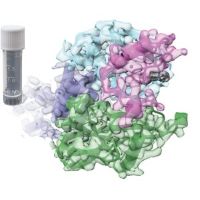Specification
| Description | Recombinant protein from the full-length sequence of Homo sapiens DnaJ heat shock protein family (Hsp40) member B2 (DNAJB2), transcript variant 1 (NM_001039550). |
| Organism | Homo sapiens (Human) |
| Expression Host | Human Cells |
| Tag Info | His or DYKDDDDK. Please contact us if you need further information or require specific designed tag. |
| Purity | Greater than 90% by SDS-PAGE gel |
| Uniprot ID | P25686 |
| Entry Name | DNJB2_HUMAN |
| Gene Names | DNAJB2 HSJ1 HSPF3 |
| Alternative Gene Names | HSJ1 HSPF3 |
| Alternative Protein Names | DnaJ homolog subfamily B member 2 (Heat shock 40 kDa protein 3) (Heat shock protein J1) (HSJ-1) |
| Application | Antigens, Western, ELISA and other in vitro binding or in vivo functional assays, and protein-protein interaction studies; For research & development use only! |
| Buffer | Purified protein formulated in a sterile solution of PBS buffer, pH7.2, without any preservatives |
| Endotoxin | Endotoxin level is < 0.1 ng/µg of protein (<1EU /µg) |
| Length | 324 |
| Molecular Weight(Da) | 35580 |
| Protein Sequence | (The sequence of expressed protein may have some variation from the sequence shown below. Please contact us for the exact sequence.) MASYYEILDVPRSASADDIKKAYRRKALQWHPDKNPDNKEFAEKKFKEVAEAYEVLSDKHKREIYDRYGREGLTGTGTGPSRAEAGSGGPGFTFTFRSPEEVFREFFGSGDPFAELFDDLGPFSELQNRGSRHSGPFFTFSSSFPGHSDFSSSSFSFSPGAGAFRSVSTSTTFVQGRRITTRRIMENGQERVEVEEDGQLKSVTINGVPDDLALGLELSRREQQPSVTSRSGGTQVQQTPASCPLDSDLSEDEDLQLAMAYSLSEMEAAGKKPAGGREAQHRRQGRPKAQHQDPGLGGTQEGARGEATKRSPSPEEKASRCLIL |
Background
| Function | FUNCTION: Functions as a co-chaperone, regulating the substrate binding and activating the ATPase activity of chaperones of the HSP70/heat shock protein 70 family (PubMed:7957263, PubMed:22219199). In parallel, also contributes to the ubiquitin-dependent proteasomal degradation of misfolded proteins (PubMed:15936278, PubMed:21625540). Thereby, may regulate the aggregation and promote the functional recovery of misfolded proteins like HTT, MC4R, PRKN, RHO and SOD1 and be crucial for many biological processes (PubMed:12754272, PubMed:20889486, PubMed:21719532, PubMed:22396390, PubMed:24023695). Isoform 1 which is localized to the endoplasmic reticulum membranes may specifically function in ER-associated protein degradation of misfolded proteins (PubMed:15936278). {ECO:0000269|PubMed:12754272, ECO:0000269|PubMed:15936278, ECO:0000269|PubMed:20889486, ECO:0000269|PubMed:21625540, ECO:0000269|PubMed:21719532, ECO:0000269|PubMed:22219199, ECO:0000269|PubMed:22396390, ECO:0000269|PubMed:24023695, ECO:0000269|PubMed:7957263}. |
| Pathway | |
| Protein Families | |
| Tissue Specificity | More abundantly expressed in neocortex, cerebellum, spinal cord and retina where it is expressed by neuronal cells (at protein level) (PubMed:1599432, PubMed:12754272). Detected at much lower level in non-neuronal tissues including kidney, lung, heart, skeletal muscle, spleen and testis (at protein level) (PubMed:12754272, PubMed:1599432). Isoform 1 is more abundant in neocortex and cerebellum compared to isoform 2 (at protein level) (PubMed:12754272). {ECO:0000269|PubMed:12754272, ECO:0000269|PubMed:1599432}. |
QC Data
| Note | Please contact us for QC Data |
| Product Image (Reference Only) |  |

